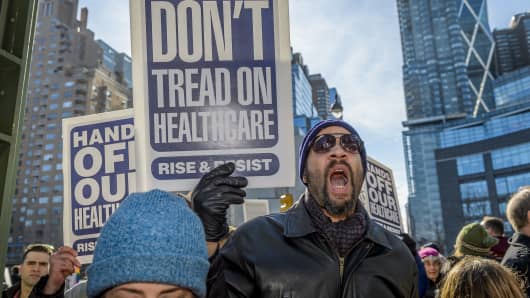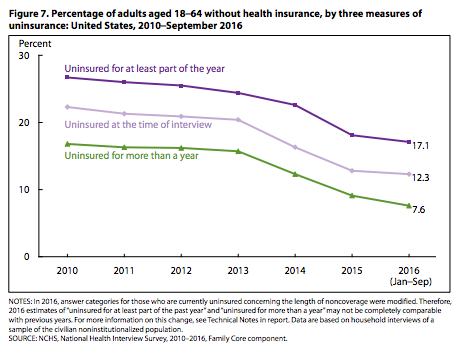The rate of uninsured Americans hits a record low as Obamacare's future remains a question mark
5 Hours AgoCNBC.com
18
SHARES

Erik McGregor | Pacific Press | LightRocket | Getty Images
Hundreds of activists and allies from the newly-formed anti-Trump group Rise & Resist staged a peaceful protest at Trump International Hotel and Tower in New York City, to fight against the radical changes to the American healthcare system proposed by the Trump Administration and Republicans.
As fewer Americans lack health insurance, more are squawking about potentially losing it.
A new survey shows that the nation's rate of people without health insurance fell further — yet again — to new lows in 2016, giving Obamacare supporters more ammunition in their ongoing fight to retain the health-care law.
In the first nine months of 2016, just 8.8 percent of Americans — or 28.2 million people — were uninsured. That's a drop of 0.3 percentage points from the same period in 2015.
Since Obamacare's coverage provisions began taking effect in 2010, the nation's uninsured rate has dropped by 7.2 percentage points, from 16 percent. That translates into 20.4 million fewer people who lacked health insurance in 2016 than in 2010. The data come from a survey released Tuesday by the National Center for Health Statistics, a division of the federal Centers for Disease Control and Prevention.
The report found a "significant" drop in the number of adults who were uninsured for more than a year between 2015 and the first nine months of 2016.
For 2015, 9.1 percent of adults reported having been uninsured for more than a year. In the first nine months of 2016, 7.6 percent of adults reported having been uninsured for more than a year.
The report was cited by advocates of Obamacare, more formally known as the Affordable Care Act, as they push back against Republican-led efforts to repeal the law. Republicans argue that Obamacare is a failure, with sharply rising premiums for individual health plans and out of pocket costs that are too high.
"The continued reduction in the uninsured rate is more historic good news from the ACA-- measured in the quality of people's lives," said Andy Slavitt, who until last month served as acting administrator for the federal Centers for Medicare and Medicaid Services.
"The very people who keep calling the law broken have the ACA's track record of covering more people with high quality benefits as a baseline to improve from," said Slavitt, whose massive former agency oversees the health-care law. "If they stop with repeal and start focusing on improvement opportunities, we can continue to make progress."
Since January, President Donald Trump and the GOP-controlled Congress have taken steps toward gutting key parts of the ACA. They also have discussed replacing the law, but so far have not come up with a proposal on how to do that.
At the same time, there have been increasingly vocal protests by people concerned about repeal efforts, with confrontations with members of Congress at town halls and other venues to express their worries. As those protests have grown, Republicans have shown an increasing hesitancy about the pace and scope of repeal.
While many Americans are unhappy with parts of Obamacare, Republicans are now facing the politically difficult — if not impossible task — of rolling back some or all of the law without causing millions of people to lose their insurance.
"Instead of rushing to rip health care away from 30 million people, Republicans need to show us a plan that protects the care millions depend on," said Meaghan Smith, a spokeswoman for the Alliance for Healthcare Security, an Obamacare advocacy group.
The figure Smith cited is based on an Urban Institute report that found about 30 million people could lose health coverage if Congress partially repealed Obamacare through the process known as budget reconciliation, without adopting replacement legislation.
"As growing crowds speak out across the country, new evidence mounts daily showing the devastating impact of Republicans' reckless agenda to repeal our health care and blow up our health-care system without a plan," Smith said.

The ACA has led to unprecedented gains in coverage through a carrot-and-stick approach.
The stick was Obamacare's individual mandate, which required nearly all Americans to have some form of health coverage as of 2014, or pay a fine in the form of a tax penalty.
The carrot was a set of provisions that made it easier for people to get health coverage, and which in turn helped drive down the uninsured rate. The first provision to take effect was the ACA rule allowing people under age 26 to be covered by their parents' health plans.
The impact of that provision was underscored in Tuesday's report, which showed that adults ages 18 to 24 have seen their uninsured rates plunge from more than 30 percent in 2010 to 13.6 percent as of last September.
The second provision was generous levels of federal funding for states that agreed to expand their Medicaid programs to cover nearly all poor adults. More than 10 million people have become covered through that provision as 31 states adopted the expansion.
The third provision was the creation of Obamacare insurance exchanges, which sell private individual health plans. Most customers on those exchanges have low and moderate incomes, which qualifies them for federal subsidies that lower their plan's premium payments. More than 12 million people signed up for coverage on those exchanges for 2017 plans.
Tuesday's report noted that, among age groups, adults ages 25 to 34 years old have the highest uninsured rate, of 16.4 percent. Adults age 45 to 64 have an uninsured rate of just 8.6 percent.
Hispanics have the highest uninsured rate among ethnic groups, at 24.7 percent. But they've also have seen that rate fall from around 45 percent since 2010. Blacks have an uninsured rate of 15.1 percent. Whites have the lowest uninsured rate, at just 7.8 percent.
People classified as "not poor" have seen just a 4 percentage point drop, roughly, in their uninsured rates since 2010, according to the report.
But there have been sharp drops in the uninsured rates among those classified as "near poor" or "poor." Those groups, whose uninsured rates stood above 40 percent in 2010, fell well below 30 percent by last September.
The uninsured rate among poor Americans was 26 percent, while it was 23 percent for near-poor people.


No comments:
Post a Comment